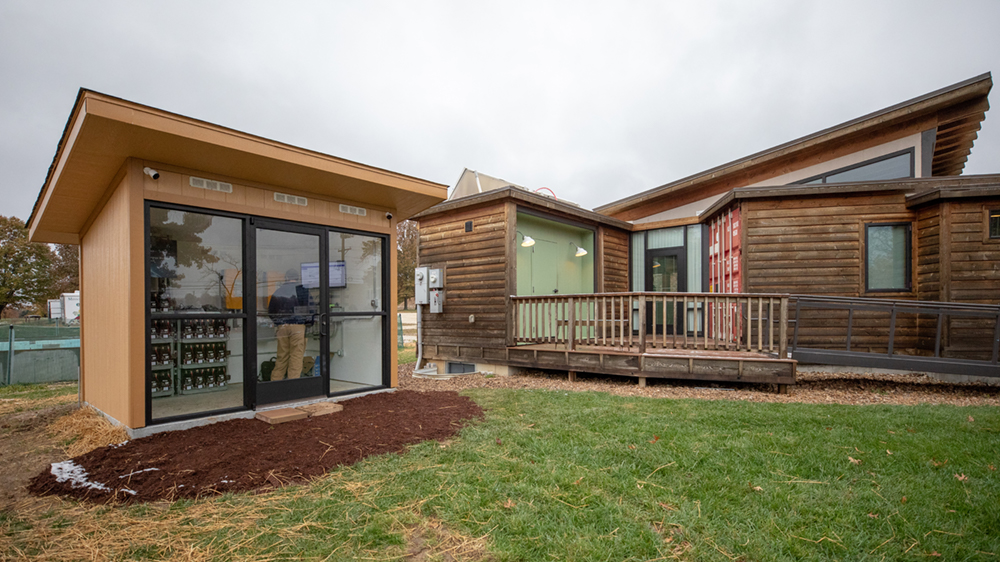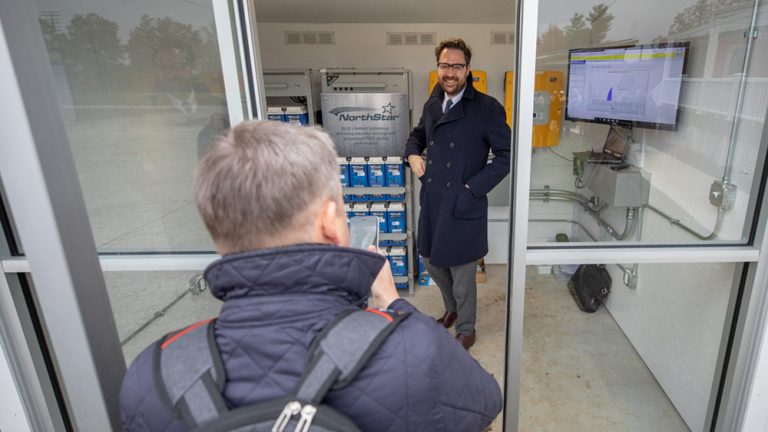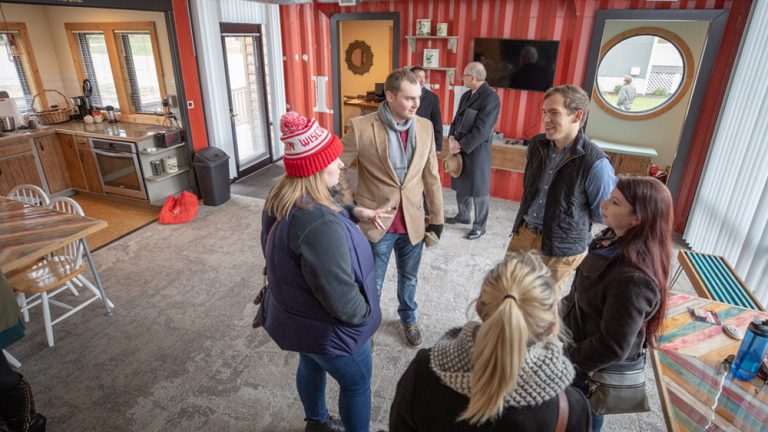 As part of the learning experience, an adjacent battery shed features a wall of windows and a door that encourages people to view the batteries and real-time energy data.
As part of the learning experience, an adjacent battery shed features a wall of windows and a door that encourages people to view the batteries and real-time energy data.For most college students, dorm living is the norm. That’s unless you’re a few lucky learners at Missouri University of Science and Technology (Missouri S&T) who reside in “living laboratories.” These students are experiencing first-hand the benefits of renewable energy by living in two on-campus solar-powered houses designed by Missouri S&T students.
The project, located in Missouri S&T’s EcoVillage in Rolla, Mo., contains two homes built for the U.S. Department of Energy’s biennial Solar Decathlon, which challenges student teams to design and create highly efficient and innovative buildings powered by renewable energy. Thomas Yarbrough, a Missouri S&T graduate student and member of the 2017 Solar Decathlon Team, noted that the EcoVillage homes are the only ones designed not only for the competition, but also to house residents.
Solving the World’s Energy Problems
At a November ribbon cutting ceremony for the project, Interim Chancellor Dr. Christopher G. Maples said, “Our mission is to integrate energy, research and application, and to apply knowledge that helps serve Missouri and helps solve the world’s energy problem.” The application portion, in particular, is what sets the EcoVillage project apart from similar research, Maples added.
“Our students are taking this demonstration to where the rubber meets the road. The world can see us making it into something useful and translating it from an ideal to actual implementation. We’ll share that knowledge to help create a better future for the next generation of communities.”
Lead Batteries Bring Power Home
Each EcoVillage solar home is individually connected to a microgrid powered by advanced lead batteries. The homes are individually supplied with stored electricity from the systems, which will run off charging algorithms from a 24-hour, cloud-based control system.
Members of Missouri S&T’s Microgrid Industrial Consortium, a collaborative research alliance, want to use the microgrids to test advancements in lead battery energy storage for potential use in renewable energy applications. Dr. Alistair Davidson, director of project partner Advanced Lead Acid Battery Consortium (ALABC), explained that the project is designed to address some of the key issues reflected in society.

Dr. Alistair Davidson, director of the Advanced Lead Acid Battery Consortium (ALABC), poses for a photo inside the battery shed. ALABC is a member of Missouri S&T’s Microgrid Industrial Consortium, a collaborative research alliance testing advancements in lead battery energy storage.
“Whether we’re talking about meeting the challenge of decarbonization or trying to find safe, secure and affordable energy storage, our focus is improving lead battery performance through research and innovation. This project will highlight the improvements that have been made in lead battery performance and also the role that lead batteries can play in meeting the demand in decarbonization and electrification.”
Davidson added that lead batteries currently comprise 75 percent of the rechargeable battery market. He said that for renewable energy, “The opportunity is so big that it can’t be met by one technology alone.” When ALABC members meet with end-users, decision makers, legislators and regulators, they often get asked about the relevance of lead batteries and their role in energy storage. Davidson said he references many of the projects underway globally, from Africa to Tibet, and now in America’s heartland, Missouri.
Project Objectives
The objectives of the project are threefold: To gather real-time insights that inform further development of residential and community-based microgrids with lead battery storage; to demonstrate the performance capability and long-term durability of advanced lead batteries as a critical component of maximizing renewable energy, and to provide students with hands-on training in renewable energy and microgrid technologies.
In past years, the houses were disassembled, loaded onto flatbed trailers, and sent to Washington, D.C., California and Colorado for the competition. Yarbrough, who designed the microgrids, is excited about the upcoming 2019-2020 challenge, when the judges will travel to Missouri S&T to judge the next project on site.
“We’re the only ones competing with an EcoVillage like this. With a permanent structure, we’ll be able to have features like a green roof, and we want to add more ground-mount solar panels and show how the different houses attach to them.”
Details about the EcoVillage Nest House
There’s quite a bit of jockeying to be selected as a resident for one of the two homes. Jordan Kubot, a member of the 2015 Solar Decathlon Team, lived in one called the Nest Home. The house is about 1,000 square feet and is described as “an innovative design that works with the environment to meet the needs of a growing family.”

Jordan Kubot (wearing black vest) lived in the Nest House for one semester. He’s shown in the home’s interior, speaking to curious students and guests during the ribbon-cutting event.
Drawing inspiration from the way birds build nests, the Nest Home incorporates several materials that were found locally and repurposed from their original use. This refutes the notion that the lifecycle of these items ends after they have outlasted their intended use. Some examples include: exterior siding composed of used shipping pallets collected from the local community; carpet composed of discarded fishing nets; a kitchen countertop inlaid with fragments of reclaimed glass bottles, and denim batting made of recycled blue jeans that provides insulation to the interior walls.
Students use home automation like Siri, Google Home and Alexa to control the lights and thermostat, to make the houses more energy efficient. The home automation system continuously monitors environmental conditions, making adjustments to the HVAC system, humidity, exterior and interior lighting, fans and windows. It integrates weather forecasts and user preferences to meet the needs of the residents. The resident has control over the entire house remotely from a wireless device, such as a tablet or smartphone.
About the Missouri S&T Microgrid Industrial Consortium
The Missouri S&T Microgrid Industrial Consortium is a collaborative research alliance that includes the Advanced Lead Acid Battery Consortium (ALABC), a research group and program of the International Lead Association; The Doe Run Company, a Missouri-based lead mining and battery recycling company; Ameren, Missouri’s largest energy utility provider; the Missouri Public Utility Alliance; the Missouri Department of Economic Development Division of Energy, and the Missouri S&T Center for Research in Energy and Environment. ALABC members NorthStar Battery and EnerSys, both global battery manufacturers, and The Doe Run Company donated the batteries, equipment and funding to construct the new microgrids.
Watch the Video: Lead Batteries Power Unique Solar “Living Laboratories”
Learn More
- Advanced Lead Acid Battery Consortium
- EnerSys
- NorthStar Battery
- The Doe Run Company
- News Release: Missouri S&T powers high-tech, living laboratory homes with new microgrids to research advanced lead battery technologies
- Missouri S&T Center for Research in Energy and Environment
- St. Louis Public Radio: Missouri S&T battery project could drive renewable energy in homes
- U.S. Department of Energy Solar Decathlon


